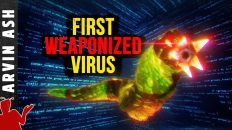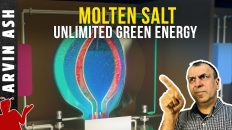At 5:30AM, dawn on July 16, 1945 near a small town called Alamagordo New Mexico, the course of human history was changed. The first atomic bomb was detonated that day, and sealed the fate of humanity.
It took the work of many people to accomplish this engineering feat, but the principle leader of the Manhattan project, and the man considered the Father of the atomic bomb was Robert Oppenheimer. After witnessing its awesome power on that fateful day, Oppenheimer was so taken aback, he quoted a phrase from the sacred Hindu text Bhagavad Gita – “Now I am become Death, the destroyer of worlds”
We know its awesome power, but how exactly does an Atom bomb work?
An atomic bomb works on the principle that when you break up the nucleus of an Atom, a large amount of energy is released. Why? Because it takes a large amount of energy to keep the nucleus bound together. When you split it apart, that energy is released.
The analogy is like a stack of bowling balls. If you were to shoot a ball into the stack, all the energy that you expended in stacking them together would be released. You can think of the nucleus of an atom being similarly “stacked” together. The larger the nucleus, the easier it is to split it apart.
Scientists chose the biggest and heaviest nucleus that is found in nature to be the best candidate for splitting –Uranium. Uranium is unique in that one of its isotopes is the only naturally occurring element that is capable of sustaining a nuclear fission reaction.
A Uranium atom has 92 protons, and 146 neutrons, together giving it an atomic mass of 238 – or U238 — the heaviest naturally occurring element on the periodic table. U238 however is generally stable in nature, and is not fissionable or “splittable” because it is so stable.
A very small portion of Uranium, when it is mined, is in the form its isotope U235. This isotope has the same 92 protons, but only 143 neutrons, or 3 fewer than U238. U235 is highly unstable. Which makes it highly fissionable or splittable. When Uranium 235 is slammed by a neutron, it becomes Uranium 236. U236 is so unstable that is almost immediately splits into two much more stable atoms, Krypton and Barium. Sometimes it can split into two other elements as well.
In the process of splitting and creating 2 more stable atoms, a whole bunch of energy is released, along with 3 neutrons. These 3 neutrons fly out and slam more U235 atoms. And a thus a chain reaction occurs causing more and more U235 to be split and ultimately causes a huge explosion.
So what’s the big deal? Why don’t all countries have an atom bomb.
The problem is that natural Uranium contains only 0.7% of this the U235 isotope. And a whole bunch of it is needed to make even one atomic bomb. So mined natural Uranium has to be “enriched” to get U235. Sometimes this is done by turning it into a gas, and letting the lighter gas flow through a one way barrier so that it rises to the top – because U235 is lighter than U238.
Another engineering challenge is to create a vessel with the correct shape and material to contain the neutrons after fissioning, so that they do not escape, but rather cause more atoms to fission. So usually a spheroid shaped holding vessel is made to contain the fissionable material. And it is lined with a special mirror so as to force the neutrons back into the fissionable material rather than escape the vessel.
Then the correct amount of fissionable material has to be placed inside this vessel. This is called a super-critical mass. This is the minimum amount of material needed for a chain reaction to occur.
This conventional explosive charge inside the container initiates the chain reaction to produce your typical mushroom cloud.
We need to thank our lucky stars that although the concept of an atom bomb is simple, the process of actually creating the bomb is not so simple.







